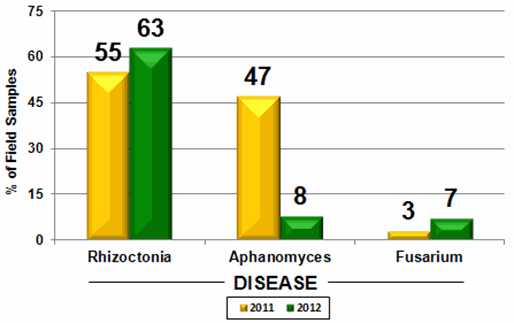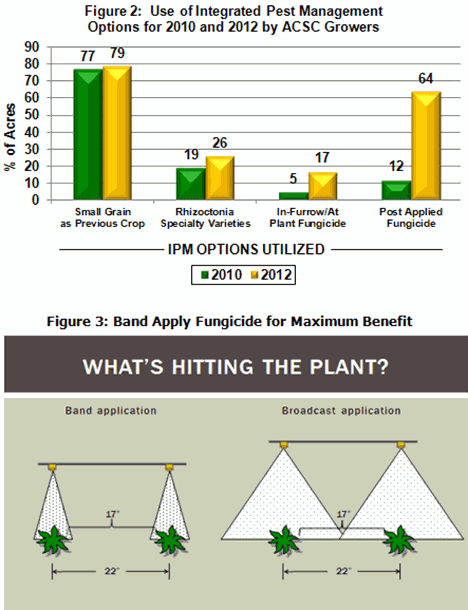576 - Rhizoctonia Management for 2013
RHIZOCTONIA ROOT AND CROWN ROT CONTINUES TO BE THE MOST SERIOUS YIELD ROBBING DISEASE OF SUGARBEETS. In spite of drier conditions in 2012 Rhizoctonia incidence was common and disease moderate to severe in many fields. Great strides have been achieved in reducing Rhizoctonia incidence and severity, but there are still unacceptable losses in many fields.
Samples of diseased roots are analyzed for root rot problems each year at the U of MN, NWROC diagnostic lab. Rhizoctonia has been the most severe problem in both a wet year (2011) and a dry year (2012), see figure one.
Figure 1. UM - NWROC Plant Pathology Laboratory Field Sample Summary for 2011-2012 - E. Crane, J. Brantner, C. Windels. *

* Results may total more than 100% if multiple diseases are diagnosed in a single sample.
Integrated Pest Management is The Key to Rhizoctonia Control Success
Every management option must be utilized to achieve success. American Crystal Sugar Company growers greatly increased utilization of IPM options between 2010 and 2012. Carefully evaluate past options used on your farm and determine where improvement is possible. Your management plan for moderate to severe Rhizoctonia should include:
- Crop rotation - follow small grain if possible
- Tolerant variety selection
- Soil temperature monitoring
- In-furrow or at-plant fungicide use
- Post-emergence fungicide use

Diagram courtesy J. Brantner, UM, NWROC
Your method of fungicide application is critical to successfully controlling Rhizoctonia. Assuming a 5 inch wide leaf area for a 4-6 leaf plant means broadcast application of fungicide places a high percentage of POST applied pesticide on the soil between the row, see Figure 3.
How much product is on the targeted plants depends on your application method. Band apply to maximize value of your expensive fungicide for best disease control, Table 1.
Table 1: Effect of Application Method on Amount of Fungicide Hitting the Plant - Brantner and Windels, U of MN, NWROC.
| Application Method | Amount of Product Hitting the Row* | |||
|---|---|---|---|---|
| Application Rate (fl oz./A.) | ||||
| 5 | 7.5 | 10 | 14.5 | |
| 5 - inch band | 5 (100%) | 7.5 (100%) | 10 (100%) | 14.5 (100%) |
| 7 - inch band | 3.6 (72%) | 5.4 (72%) | 7.1 (72%) | 10.4 (72%) |
| 11 - inch band | 2.3 (46%) | 3.8 (46%) | 5.0 (46%) | 6.6 (46%) |
| Broadcast | 1.1 (23%) | 1.7 (23%) | 2.3 (23%) | 3.3 (23%) |
* Assumes a 5 inch wide canopy for a 4-6 leaf sugarbeet
ACSC Website Resource Materials Available:
- Blue Book data
- Quick reference card for Rhizoctonia
- Your Way to Grow PowerPoint files
- Pest Alert information
- Great research reports at www.sbreb.org
Weed Resistance Management Non-Negotiables
- Practice field perimeter weed management
- Zero tolerance for weed survivors
- Scout fields diligently
- Diversify weed management strategies
- Start clean/weed free at planting
- Maximize herbicide activity
- Understand the enemy i.e. weed biology
"You have a choice, each choice has consequences" Jeff Stachler, NDSU/UM Extension Sugarbeet Weed Specialist.
Weed Resistance Management
The time for action is NOW. Next year or 2014 may well be too late. Spend a little now or pay a great deal later.
As Benjamin Franklin once said:
"He that is good at excuses is seldom good for anything else". This quote is especially pertinent to taking action against weed resistance now."
Contact your Agriculturist to develop a complete crop rotation weed resistance management plan for your farm.
